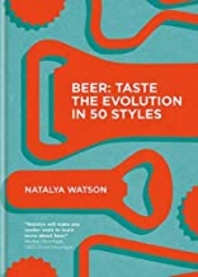Beer styles: Watson is in her element
Added: Tuesday, March 24th 2020

Beer: Taste the Evolution in 50 Styles, Natalya Watson (Kyle Books, £15.99)
This is a cleverly conceived book. At one level, it’s aimed at people who enjoy beer but are not experts and they will gain a great deal from studying it. But there are also nuggets of information, advice and choice of beers that will also inform those who can tell a Target from a Tettnanger.
The author grew up in Northern Ireland but her family went to California where she studied microbiology at University College of Los Angeles. Equally important, she discovered beer and when she moved to London she worked as the UK marketing manager for the big Belgian brewer Duvel Moortgat. As well as teaching and judging beer, she is now the secretary of the British Guild of Beer Writers.
As far as I’m concerned, anyone who helped promote Duvel, one of the world’s greatest ales, is fully qualified to write a book about beer.
Natalya begins with the raw materials used in brewing. She describes the different types of malt available, from the palest Pilsner to the blackest black. They’re all made from barley but she adds that other grains such as wheat, oats and rye can be used. Slightly tongue in cheek, she also points out that corn, rice and sugar can be added “to thin the beer...and keep it light and crisp”. I wonder who she has in mind?
The importance of water in the brewing process is often overlooked or down played but Natalya rightly stresses its key role in making beer, with soft water needed for lager brewing and mineral-rich water required for ales, pale ales in particular.
Natalya deals a length with hops, describing the history of the plant and its slow adoption by sceptical brewers in the 15th and 16th centuries. She explains that, with the rapid development of commercial brewing in more recent times, the ability of hops to give beer a long, bacteria-free “shelf life” made its use mandatory.
Hop breeding and the development of many new varieties is followed by an explanation of the veritable explosion of interest in the plant in recent years and the massive growth of “hop forward” beers with profound hop aromas, flavours and bitterness.
The book explains the way yeast converts malt sugars into alcohol, the science of which was not understood for centuries. Natalya describes how lager yeast was refined and cultured in the 19th century to enable lager beer to become the world's leading type of beer. She analyses the key differences between ale and lager yeasts and goes on to describe how wild yeasts perrform when making lambic and guezue types of beer in Belgium.
The book skims – the author’s term – the history of beer from the dawn of history and the domestication of cereals and then leads into the major section of the book: styles ancient and modern. Each style is accompanied by a chosen beer that highlights its main characteristics: I was pleased to find that Natalya chose Worthington’s White Shield as a prime example of a traditional English IPA. She deftly finds a path through the minefield of the origins of porter and stout where several beer historians have exploded with a large outpouring of gas.
The book, as befits a young writer with her finger on the pulse, is up to date with such modern styles of beer as American interpretations of IPA, stout, Pilsner and Belgian saison. I’m glad Natalya carefully differentiates between sour beers that derive from Belgian “sour red” which are not the same as lambic and gueuze produced by wild or spontaneous fermentation.
It’s a jolly romp of a book, neatly written and an excellent primer for seasoned drinkers and those coming new to beer. It will serve to widen the knowledge and appreciation of the world’s favourite alcoholic drink.








